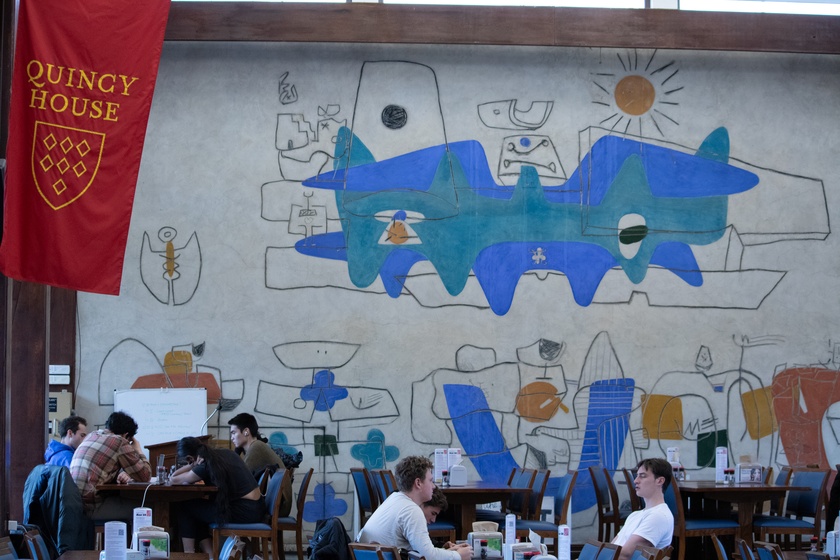{shortcode-c18d05ce53f947a299b9e77ff07ff26ea01d4660}
{shortcode-be29865d8a9c7908fa05930b7f2d42574eaa573c}n Lowell, the dining hall is decorated with a crystal chandelier and Ionic columns. In Winthrop’s dining hall, the walls are adorned with framed portraits of the eponymous Winthrop family. In Dunster, former deans’ portraits stare down at you, either ominously or protectively — depending on your perspective.
Harvard is old — a fact not lost on anyone here. Yet, as many Houses undergo renovations, Harvard is contemplating how to reconcile nostalgia for the past with its desire for modern relevance.
The original river Houses looked “more like palatial residences than college dormitories,” according to “Harvard: An Architectural History.” Their architecture was a “conscious imitation” of earlier colonial styles. These Houses were intentionally designed to both connect to Harvard’s long history and to project an image of aristocratic sophistication.
“We live, in some ways, in what wants to be the 19th-century or the 18th-century,” says Luise Z. H. Mörke, a PhD student in Art, Film, and Visual Studies at Harvard and a resident arts tutor for Cabot House.
There is often little room, in such designs, for modern or student-produced art. The Houses “have a particular architecture,” Mörke says, that “already determines what is possible in a given space, or what works in a given space.” Conformity to these past styles, she says, is often what contemporary art “is up against.”
Some students are up for the challenge. In Winthrop’s dining hall, alongside its large aristocratic portraits — including one of the controversial John Winthrop himself — Ethan-Judd “EJ” M. Barthelemy ’27 tapes up his photographs, along with a tag for his Instagram photography account @ejtookthat. These too are portraits, free-form street shots of ordinary figures in the city.
When he first placed the photographs in Winthrop’s regal dining hall last September, Barthelemy says that he “fully expected someone to come by and take them down.” But they have remained — accompanying the dining hall portraits and plaques engraved with donor names that sit upon Winthrop’s newly-renovated walls.
Lately, Winthrop House has been reckoning with its own connection to the past and its namesake John Winthrop, the slave-owning first governor of the Massachusetts Bay Colony. In 2023, over 200 Harvard affiliates signed a petition calling for the denaming of Winthrop House.
“There’s always going to be a lot of history wherever you go, at any big institution,” Barthelemy says. He finds it meaningful to see more student artwork on the walls because “you get to emphasize what’s here now in the present and what’s going to be there in the future as well as the past.”
Winthrop is by no means the only House wrestling with its history through art and design. Adams House, the self-proclaimed “most historic House,” has attempted to maintain its historicity through its recent renovation. The renovation seeks to continue a centuries-old House culture of refined living experiences that began in the late 19th century with the renting of its halls to “rich Harvard men,” according to history documentation on the House website.
But at times, Adams’ associations with its aristocratic past have also brought the unsavory aspects of that past into the present, such as with the “racist caricatures” that were recently awkwardly concealed on a Westmorly Court fireplace.
As Adams grapples with its past, it also reckons with contentious contemporary displays.
Last year, Adams House featured a student art exhibit titled “Legacy, 2024” during Black History Month, which connected Black organizers with the Palestine Solidarity Committee to Black leaders in the Civil Rights Movement.
According to Adams House Arts Tutor Madeleine D. Woods ’19, “within Adams House, art has always been essential, and it’s often been subversive. Most of our artwork has always been intensely progressive.”
Some Houses have attempted to incorporate more modern art into their official House decor — to mixed reactions.
In Quincy House, the dining hall boasts a 30 by 16 foot graffito created by the Italian sculptor and Harvard teacher Costantino Nivola. When it was first unveiled in 1959, many Harvard affiliates decried the abstract work, which was variously described in this magazine as “fingerpainting” and “insane doodling.” Such criticisms were part of a broader discomfort with modern art in America, as artists and culture moved away from the formal art and society of earlier periods.
In Kirkland, deemed the “quirky” House for their traditions such as “The Choosening,” the administration has tried to strike a balance between modernizing (Kirkifying?) the House’s decor, while preserving its antique interior. In the stifling Junior Common Room, abstract expressionist paintings — featuring large black brushstrokes swooping around other saturated splotches of paint — and an abstract sculpture made of colorful fabrics formed into a 3D jumble are mounted between traditional portraits and an ornate carved wooden grotesque of the Harvard seal.
Kirkland House historian and former Crimed Ivor K. Zimmerman ’23 tells me that the House added the modern art to replace three traditional portraits. Following student input and a search committee, a final House-wide vote decided on the currently displayed modern art.
The whole process was designed to install new democratically-selected art, while ensuring that the addition would not remove any displayed House history. (Zimmerman assures me there was little connection between the removed portraits and Kirkland’s history.)
Similarly, in Dunster, administrators have tried to use art to display contemporary House values.
A modern artwork titled “Harbor of Diaspora” perches on a dark wood panel. The painting itself — taking up nearly the whole wall — is a blur of blue and yellow brush strokes, somewhere between a late Monet and a Jackson Pollock on the abstraction scale.
The artwork “resonates deeply with Dunster House’s values of diversity, inclusion, and the celebration of different cultural journeys” and captures “the tension between hope and contradiction in the quest for new beginnings.” Or at least, that’s what the descriptive placard next to the painting says. Purchased with funding meant to “foster inclusivity in Harvard’s residential spaces,” the painting is an attempt to inject modern values and artwork into Dunster’s historic space.
As I stopped to admire the painting and learn its official meaning, everyone around me merely gave it a cursory glance on their way through the corridor. Despite the efforts of Houses to exhibit modernity and proclaim House values through displayed artwork, the students I see are more busy with their own present lives.
“I think most students throughout the day will take a glance, maybe try and see if they recognize any of the figures represented in the portraits here,” says Rahul K. Arora ’26, co-chair of the Lowell House Committee, while standing under the Lowell dining hall chandelier. “Outside of that,” he continues, “I wouldn’t say it has a large impact on our day-to-day.”
—Madelyn McKenzie contributed reporting.


